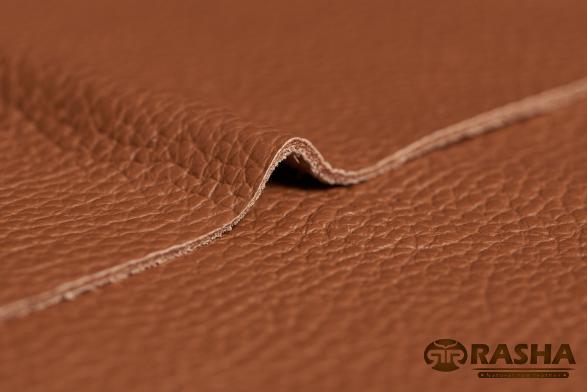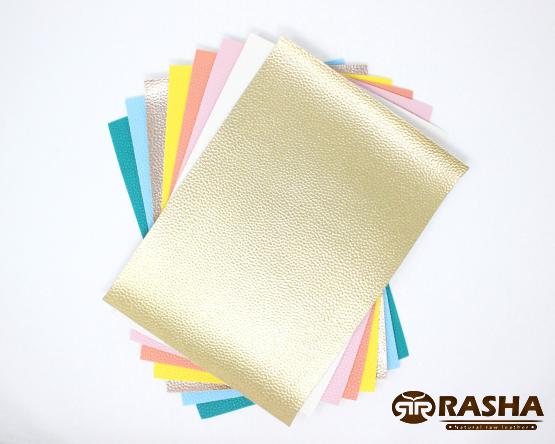Leather, known for its durability and timeless appeal, has been a popular material choice in various industries for centuries. Two of the most widely used leather categories are lamb leather and cow leather. Each type possesses unique characteristics that make them suitable for different applications. In this article, we will explore the differences between lamb leather and cow leather in terms of their source, quality, appearance, durability, and pricing. By understanding these distinctions, businesses and consumers can make informed decisions when selecting leather for their specific needs. 1. Source and Quality: Lamb Leather: Obtained from young sheep, lamb leather is valued for its softness and fine grain. The luxurious texture and suppleness of lamb leather arise from the animal’s limited exposure to the environment, resulting in fewer marks and imperfections. The high quality of lamb leather makes it particularly suitable for luxury fashion items such as handbags, accessories, and apparel. Cow Leather: Derived from mature cattle, cow leather is widely available and typically less expensive than lamb leather. It is renowned for its strength and durability due to the thickness of the hides. Though cow leather may contain more natural imperfections, such as stretch marks and scars, these can be minimized or disguised during the tanning process. Cow leather is commonly used in furniture, belts, footwear, and automotive upholstery due to its sturdiness. 2. Appearance and Texture: Lamb Leather: Lamb leather has a smooth, buttery texture and a fine grain that allows for an elegant finish. The smaller size of lambskin hides creates a seamless look when used in garments or smaller accessories. The lightweight nature of lamb leather also makes it easy to drape and mold, lending itself well to tailored designs that require a close fit. The supple feel and lustrous appearance make lamb leather a popular choice for high-end fashion products. Cow Leather: Cow leather typically possesses larger, more noticeable grains and a thicker surface. The grain texture is coarser, giving it a rugged and natural appeal. However, cow leather can be split into layers, with the top grain being the most desirable and the full-grain retaining the natural characteristics. Full-grain cow leather is often used in premium products to showcase the hide’s unique characteristics and provide a rustic appearance. 3. Durability and Longevity: Lamb Leather: While lamb leather is incredibly soft and pliable, it is not as durable as cow leather due to its naturally thinner structure.

leather
 Lamb leather tends to be more delicate and prone to wear and tear, requiring extra care to maintain its condition. However, advancements in leather processing techniques have allowed for the production of more durable lamb leather variants, extending their longevity and resistance to abrasion. Cow Leather: Considered one of the most durable and long-lasting leather types, cow leather is known for its robustness and ability to withstand heavy use. The thickness and toughness of cowhide make it resistant to tearing and stretching, making it a popular choice for applications that require strength. With proper care and maintenance, cow leather products can retain their appearance and functionality for many years, making them a reliable option for rugged use. 4. Pricing: Lamb Leather: Lamb leather is generally more expensive than cow leather due to the factors influencing its production. The limited availability of lamb hides, coupled with their higher quality and finer texture, contribute to a higher price point. Additionally, the process of tanning and finishing lamb leather requires meticulous attention to detail, further adding to the costs involved. Cow Leather: Cow leather is typically more affordable than lamb leather due to its wider availability and the larger size of cow hides. With a more abundant supply and easier obtainability, cow leather is produced in greater quantities, resulting in a lower price range. However, the price can vary based on the specific processing techniques used and the quality of the cowhide, such as full-grain or top-grain varieties. Conclusion: When considering lamb leather versus cow leather, understanding their unique properties and characteristics is essential for making well-informed decisions. Lamb leather’s premium quality, exceptional softness, and luxurious appearance make it ideal for high-end fashion products. On the other hand, cow leather’s durability, strength, and affordability make it a popular choice for applications where sturdiness and longevity are paramount. Ultimately, choosing between lamb leather and cow leather depends on the specific requirements of your project or products. By carefully evaluating the desired qualities such as softness, durability, or cost-effectiveness, businesses and consumers can select the most suitable leather type for their needs. I. Lamb Leather in High-End Fashion: Lamb leather’s luxurious texture and elegant appearance make it a favored choice in high-end fashion industry. Designers often opt for lamb leather due to its softness and supple nature, which allows for intricate detailing and draping. It is commonly used in the creation of luxurious handbags, wallets, gloves, and bespoke apparel, where the delicate feel of the leather enhances the overall aesthetic. Lamb leather’s ability to effortlessly conform to the body also makes it ideal for tailored garments, providing a comfortable and flattering fit.
Lamb leather tends to be more delicate and prone to wear and tear, requiring extra care to maintain its condition. However, advancements in leather processing techniques have allowed for the production of more durable lamb leather variants, extending their longevity and resistance to abrasion. Cow Leather: Considered one of the most durable and long-lasting leather types, cow leather is known for its robustness and ability to withstand heavy use. The thickness and toughness of cowhide make it resistant to tearing and stretching, making it a popular choice for applications that require strength. With proper care and maintenance, cow leather products can retain their appearance and functionality for many years, making them a reliable option for rugged use. 4. Pricing: Lamb Leather: Lamb leather is generally more expensive than cow leather due to the factors influencing its production. The limited availability of lamb hides, coupled with their higher quality and finer texture, contribute to a higher price point. Additionally, the process of tanning and finishing lamb leather requires meticulous attention to detail, further adding to the costs involved. Cow Leather: Cow leather is typically more affordable than lamb leather due to its wider availability and the larger size of cow hides. With a more abundant supply and easier obtainability, cow leather is produced in greater quantities, resulting in a lower price range. However, the price can vary based on the specific processing techniques used and the quality of the cowhide, such as full-grain or top-grain varieties. Conclusion: When considering lamb leather versus cow leather, understanding their unique properties and characteristics is essential for making well-informed decisions. Lamb leather’s premium quality, exceptional softness, and luxurious appearance make it ideal for high-end fashion products. On the other hand, cow leather’s durability, strength, and affordability make it a popular choice for applications where sturdiness and longevity are paramount. Ultimately, choosing between lamb leather and cow leather depends on the specific requirements of your project or products. By carefully evaluating the desired qualities such as softness, durability, or cost-effectiveness, businesses and consumers can select the most suitable leather type for their needs. I. Lamb Leather in High-End Fashion: Lamb leather’s luxurious texture and elegant appearance make it a favored choice in high-end fashion industry. Designers often opt for lamb leather due to its softness and supple nature, which allows for intricate detailing and draping. It is commonly used in the creation of luxurious handbags, wallets, gloves, and bespoke apparel, where the delicate feel of the leather enhances the overall aesthetic. Lamb leather’s ability to effortlessly conform to the body also makes it ideal for tailored garments, providing a comfortable and flattering fit.
Specifications of leather
 II. Cow Leather in Functional and Durable Products: While lamb leather excels in the realm of luxury fashion, cow leather’s strength and durability make it a reliable choice for functional products. Furniture manufacturers, for instance, appreciate the resilience of cow leather in upholstering chairs, sofas, and ottomans. Its sturdiness allows for heavy use without compromising on quality. The rugged appearance and larger grain texture of cow leather also make it popular in the production of belts, boots, and other footwear that require long-lasting and sturdy materials. III. Sustainability Considerations: In recent years, sustainability has become a prime concern across industries, including the leather sector. Choosing between lamb leather and cow leather can have implications for sustainability. Lamb leather, being softer and thinner, is often sourced from younger animals, resulting in lower meat yield. This practice can raise concerns regarding animal welfare and the environmental impact of animal husbandry. Cow leather, on the other hand, is usually a byproduct of the meat industry. It utilizes hides that would otherwise go to waste, making it a more sustainable choice in terms of resource utilization. Additionally, advancements in environmentally friendly tanning processes, such as vegetable tanning, are making cow leather even more eco-friendly. IV. Ethical Considerations: Ethical considerations surrounding the use of animal products also come into play when comparing lamb leather and cow leather. Some consumers have concerns about animal welfare, particularly regarding the sourcing of lamb leather from young animals. While industry regulations exist to ensure humane animal treatment, it is important for businesses to communicate their sourcing and production practices to customers who prioritize ethical considerations. Cow leather, on the other hand, has a more established supply chain and ample regulatory frameworks to ensure ethical sourcing. It is crucial for businesses to prioritize transparency and responsible sourcing practices to address consumer concerns and maintain ethical standards. V. Leather Care and Maintenance: Both lamb leather and cow leather require regular care and maintenance to preserve their quality and extend their lifespan. However, there are slight differences in the care routines for each type. Lamb leather is more delicate and prone to scratches and scuffs, therefore, it is important to handle it with care. Regular application of leather conditioners and protective sprays can help maintain its softness and protect it from environmental damage. Cow leather, being more durable, is generally easier to maintain. Regular cleaning and conditioning are recommended to prevent dryness and cracking. Since cow leather is less prone to damage, it can withstand more rigorous cleaning processes if needed. VI. Tanning and Finishing Processes: Tanning and finishing techniques play a crucial role in the quality and appearance of both lamb leather and cow leather. Lamb leather, with its finer grain, requires careful handling during the tanning process to retain its natural softness and luster. The selection of specific tanning methods, such as chrome tanning or vegetable tanning, can influence the final properties and characteristics of the leather. Cow leather, due to its thickness, is generally processed using a wider range of tanning techniques. The selection of top-grain or full-grain cow leather can provide different finishes, with full-grain showcasing the natural imperfections of the hide and top-grain offering a more refined appearance. The tanning and finishing processes determine the final color, texture, and overall quality of the leather. VII. Market Demand and Trends: The market demand for both lamb leather and cow leather varies depending on industry trends and consumer preferences.
II. Cow Leather in Functional and Durable Products: While lamb leather excels in the realm of luxury fashion, cow leather’s strength and durability make it a reliable choice for functional products. Furniture manufacturers, for instance, appreciate the resilience of cow leather in upholstering chairs, sofas, and ottomans. Its sturdiness allows for heavy use without compromising on quality. The rugged appearance and larger grain texture of cow leather also make it popular in the production of belts, boots, and other footwear that require long-lasting and sturdy materials. III. Sustainability Considerations: In recent years, sustainability has become a prime concern across industries, including the leather sector. Choosing between lamb leather and cow leather can have implications for sustainability. Lamb leather, being softer and thinner, is often sourced from younger animals, resulting in lower meat yield. This practice can raise concerns regarding animal welfare and the environmental impact of animal husbandry. Cow leather, on the other hand, is usually a byproduct of the meat industry. It utilizes hides that would otherwise go to waste, making it a more sustainable choice in terms of resource utilization. Additionally, advancements in environmentally friendly tanning processes, such as vegetable tanning, are making cow leather even more eco-friendly. IV. Ethical Considerations: Ethical considerations surrounding the use of animal products also come into play when comparing lamb leather and cow leather. Some consumers have concerns about animal welfare, particularly regarding the sourcing of lamb leather from young animals. While industry regulations exist to ensure humane animal treatment, it is important for businesses to communicate their sourcing and production practices to customers who prioritize ethical considerations. Cow leather, on the other hand, has a more established supply chain and ample regulatory frameworks to ensure ethical sourcing. It is crucial for businesses to prioritize transparency and responsible sourcing practices to address consumer concerns and maintain ethical standards. V. Leather Care and Maintenance: Both lamb leather and cow leather require regular care and maintenance to preserve their quality and extend their lifespan. However, there are slight differences in the care routines for each type. Lamb leather is more delicate and prone to scratches and scuffs, therefore, it is important to handle it with care. Regular application of leather conditioners and protective sprays can help maintain its softness and protect it from environmental damage. Cow leather, being more durable, is generally easier to maintain. Regular cleaning and conditioning are recommended to prevent dryness and cracking. Since cow leather is less prone to damage, it can withstand more rigorous cleaning processes if needed. VI. Tanning and Finishing Processes: Tanning and finishing techniques play a crucial role in the quality and appearance of both lamb leather and cow leather. Lamb leather, with its finer grain, requires careful handling during the tanning process to retain its natural softness and luster. The selection of specific tanning methods, such as chrome tanning or vegetable tanning, can influence the final properties and characteristics of the leather. Cow leather, due to its thickness, is generally processed using a wider range of tanning techniques. The selection of top-grain or full-grain cow leather can provide different finishes, with full-grain showcasing the natural imperfections of the hide and top-grain offering a more refined appearance. The tanning and finishing processes determine the final color, texture, and overall quality of the leather. VII. Market Demand and Trends: The market demand for both lamb leather and cow leather varies depending on industry trends and consumer preferences.
buy leather
 The fashion industry, with its emphasis on luxury and exclusivity, often leans towards lamb leather for its premium quality and softness. However, in recent years, there has been a growing interest in sustainability and ethical sourcing, driving demand for cow leather in various sectors. Moreover, the rise of conscious consumerism has led to a surge in demand for alternative leather options, such as vegan leather. Businesses operating in the leather industry must stay updated with consumer preferences and adapt their product offerings to cater to changing market demands. VIII. Application in Automotive and Upholstery: Apart from fashion, both lamb leather and cow leather find applications in automotive upholstery. Luxury car manufacturers often opt for lamb leather to create a sophisticated and comfortable interior. The softness and smoothness of lamb leather provide a luxurious feel for drivers and passengers. Cow leather, with its durability and strength, is frequently used in entry-level luxury cars as well as in commercial vehicles where longevity and resistance to wear are important considerations. IX. Regional Preferences: Regional preferences and cultural influences can also impact the choice between lamb leather and cow leather. In certain markets, lamb leather may be highly favored due to its association with luxury and opulence, while in others, cow leather may be more commonly used due to its affordability and availability. Understanding regional preferences and market dynamics becomes crucial when catering to specific consumer demands. X. Emerging Technologies and Leather Alternatives: Advancements in technology have led to the development of leather alternatives that are becoming increasingly popular in the market. Synthetic leathers, such as PVC or PU leather, offer a cruelty-free option that mimics the appearance and texture of genuine leather at a lower cost. These alternatives provide businesses with additional choices when considering leather materials for their products. Conclusion: Lamb leather and cow leather each have their own unique characteristics and applications. While lamb leather excels in luxury fashion products due to its softness and fine texture, cow leather is preferred for its durability and affordability in functional and durable products. By understanding the distinguishing features of these two types of leather, businesses can make informed decisions based on their specific needs and market demands. Taking into account factors such as sourcing, quality, appearance, durability, and ethical considerations, businesses can select the most suitable leather option for their products, ensuring customer satisfaction and long-term success.
The fashion industry, with its emphasis on luxury and exclusivity, often leans towards lamb leather for its premium quality and softness. However, in recent years, there has been a growing interest in sustainability and ethical sourcing, driving demand for cow leather in various sectors. Moreover, the rise of conscious consumerism has led to a surge in demand for alternative leather options, such as vegan leather. Businesses operating in the leather industry must stay updated with consumer preferences and adapt their product offerings to cater to changing market demands. VIII. Application in Automotive and Upholstery: Apart from fashion, both lamb leather and cow leather find applications in automotive upholstery. Luxury car manufacturers often opt for lamb leather to create a sophisticated and comfortable interior. The softness and smoothness of lamb leather provide a luxurious feel for drivers and passengers. Cow leather, with its durability and strength, is frequently used in entry-level luxury cars as well as in commercial vehicles where longevity and resistance to wear are important considerations. IX. Regional Preferences: Regional preferences and cultural influences can also impact the choice between lamb leather and cow leather. In certain markets, lamb leather may be highly favored due to its association with luxury and opulence, while in others, cow leather may be more commonly used due to its affordability and availability. Understanding regional preferences and market dynamics becomes crucial when catering to specific consumer demands. X. Emerging Technologies and Leather Alternatives: Advancements in technology have led to the development of leather alternatives that are becoming increasingly popular in the market. Synthetic leathers, such as PVC or PU leather, offer a cruelty-free option that mimics the appearance and texture of genuine leather at a lower cost. These alternatives provide businesses with additional choices when considering leather materials for their products. Conclusion: Lamb leather and cow leather each have their own unique characteristics and applications. While lamb leather excels in luxury fashion products due to its softness and fine texture, cow leather is preferred for its durability and affordability in functional and durable products. By understanding the distinguishing features of these two types of leather, businesses can make informed decisions based on their specific needs and market demands. Taking into account factors such as sourcing, quality, appearance, durability, and ethical considerations, businesses can select the most suitable leather option for their products, ensuring customer satisfaction and long-term success.










Your comment submitted.